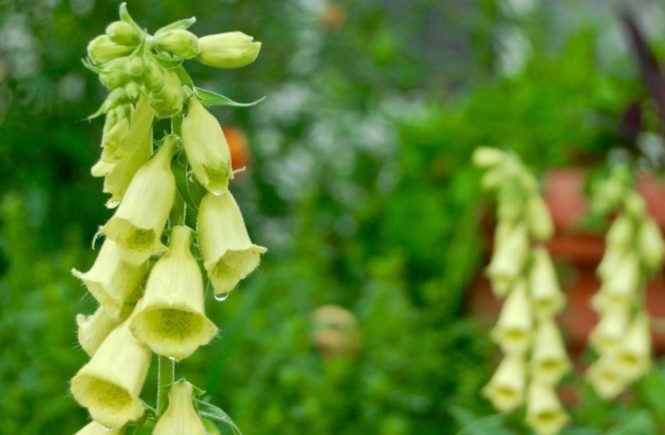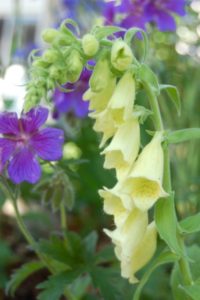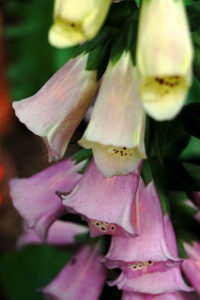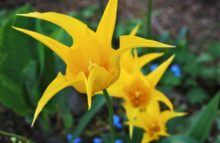By dint of name alone, foxgloves are like fairy flowers. If foxes wore gloves, they might look a bit like these.
 The bell-shaped flowers remind me of the kind of thing I might have seen fairies wearing for hats — along with the fuzzy caps of poppies – in the British children’s books I grew up with. Something illustrated by Maud Lucie Atwell.
The bell-shaped flowers remind me of the kind of thing I might have seen fairies wearing for hats — along with the fuzzy caps of poppies – in the British children’s books I grew up with. Something illustrated by Maud Lucie Atwell.
The first image is a perennial foxglove (Digitalis grandiflora). It’s paired in Sarah’s front garden with perennial Geranium magnificum. The lovely cream-coloured foxglove with its shepherd’s crook stems complements any colour in the garden and makes a fountain of light in a shady spot.
The other photo is of a biennial, the more common form of the flower, Digitalis purpurea – probably the cultivar ‘Foxy,’ from the garden of neighbour T. I love the gradation of colour, from the creamy immature flowers to the deeper purple shades, all spotted inside. The embedded link leads to great info on both from the University of Saskatchewan.
The writers at U. Sask. are not quite right in saying that the grandiflora is the only perennial form. Among others, we both have the dainty D. lutea, with tiny thimble-shaped flowers.
I have also tried (unsuccessfully; are you surprised?) to grow D. x mertonensis, simply because of the colour which is often described as “crushed strawberry.” I suspect my garden just isn’t moist enough – but, with his juicy soil, T. would have great success just a few doors down. That’s the difference feeding the soil makes.
Like most perennials that knock themselves out flowering, the perennial foxgloves are a bit short-lived. The mother plant may last three years. Deadheading the individual thimbles as they seed-up will extend the bloom in season. However, leave a last spike or two to set seed, and you might have foxgloves for a lifetime. We’ve found the grandifloras and the luteas to be particularly tough.
The biennial form is much taller and showier, however, and occasionally will give you a second season of flowers, despite themselves. They won’t make flower spikes for you their first season, though. Like most things in the garden, they’re good for cultivating patience.






